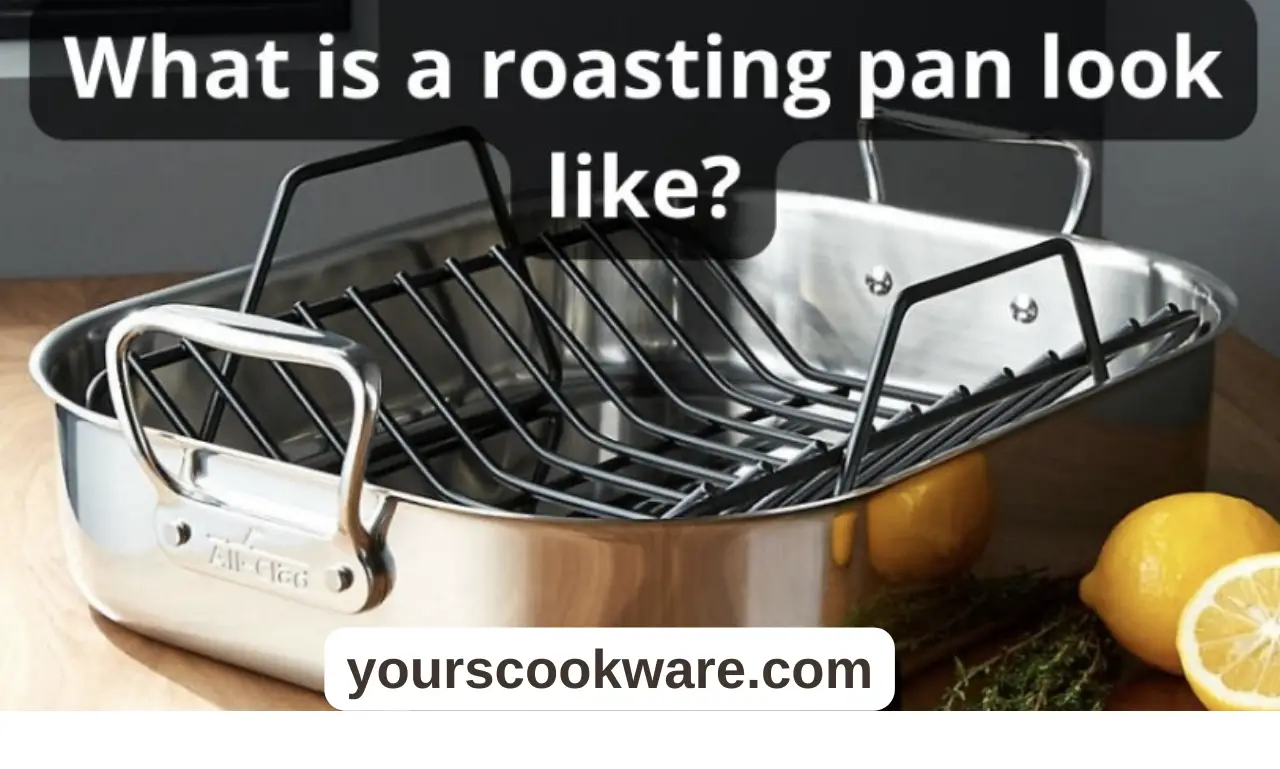What is a roasting pan look like? Roasting pans are the unsung heroes of the kitchen, often overlooked but essential for preparing succulent, evenly cooked dishes that leave your family and guests craving for more.
Whether you’re an aspiring home chef or a seasoned pro, understanding the characteristics and benefits of a roasting pan is a must. Roasting pans also have the versatility to transform into a paella pan as a roasting pan alternative, allowing you to explore a wide range of culinary possibilities, from traditional roasts to international dishes.
In this article, we’ll take a deep dive into what a roasting pan looks like- this indispensable kitchen tool.
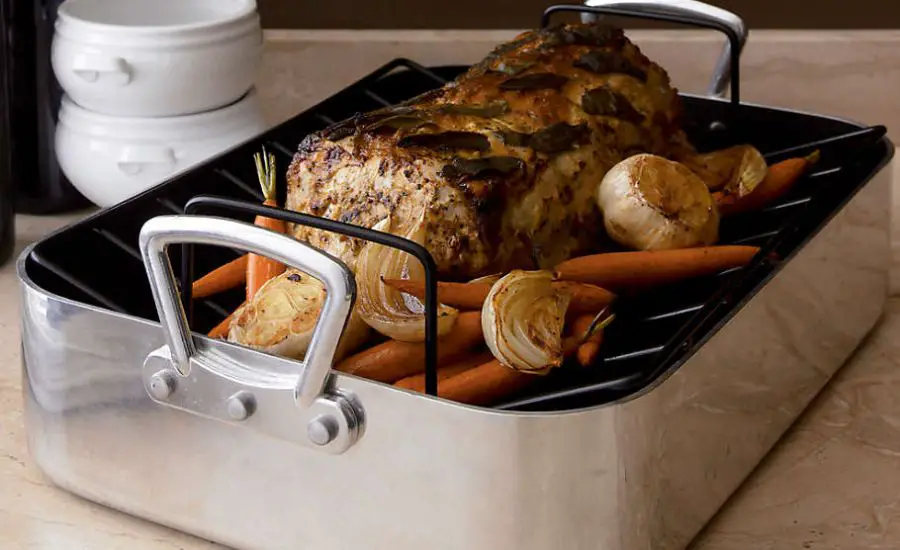
The anatomy of a roasting pan
A roasting pan, a kitchen essential, consists of a large, shallow container typically made from stainless steel, aluminum, or other durable materials.
A distinguishing element of roasting pans is the inclusion of a removable rack, designed to elevate the food and allow air to circulate, ensuring even cooking and that delicious crispy texture.
Many oven pans also come with a drip pan, which captures flavorful juices and prevents messes in your oven.
It’s worth mentioning that this versatile concept extends to other kitchen tools like a cast iron skillet, both of which can be ingeniously repurposed for roasting, While a cast iron skillet can work in a pinch for roasting, the roasting pan’s design is optimized for this specific culinary task.
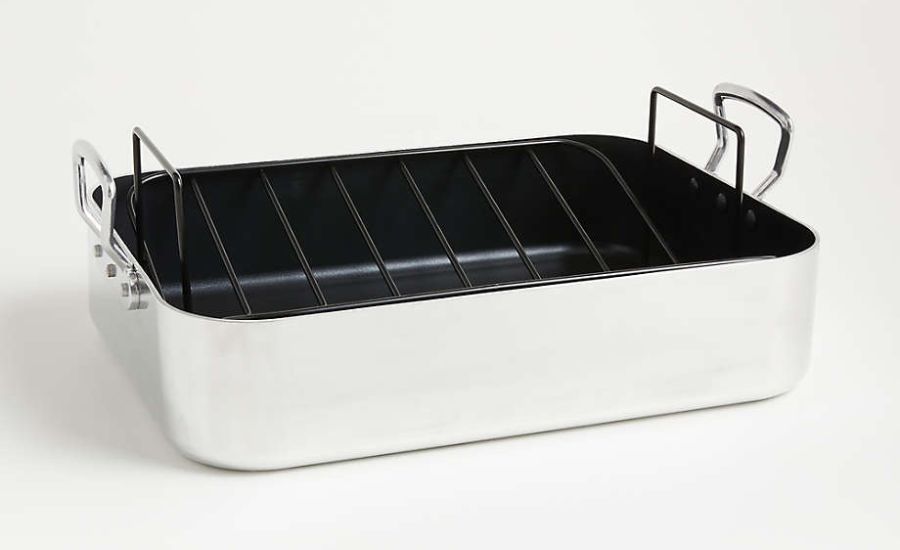
Types of roasting pan construction
Stainless steel oven pans are known for their durability and resistance to staining, making them easy to clean.
Aluminum roasting pans are lightweight and heat up quickly, ensuring even cooking.
Cast iron oven pans excel at heat retention, providing a perfect environment for achieving rich, caramelized flavors.
Nonstick pans offer the added convenience of easy food release and cleanup.
When selecting a roasting pan, your choice of construction should align with your specific culinary preferences and cooking needs.
Handles and design
Many oven pans feature riveted or welded handles for added strength and durability. When opting for an oven-safe skillet, the handle’s design should facilitate easy transfer from stovetop to oven without the need for pot holders.
In contrast, a large casserole dish may come with oversized, heat-resistant handles to accommodate the weight of a hearty casserole. A shallow roasting pan typically offers handles at both ends, allowing for a balanced grip when maneuvering it in and out of the oven.
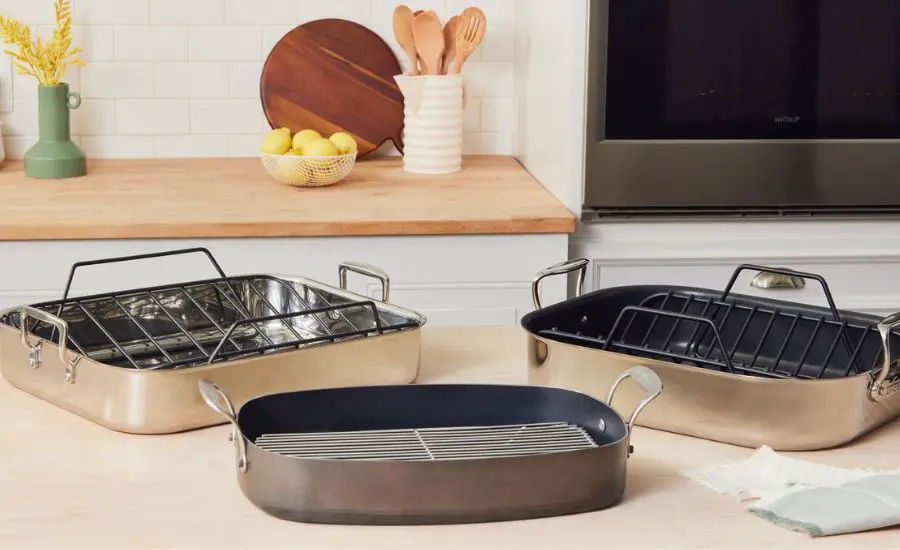
Roasting rack
The inclusion of roasting racks within a roasting pan is a game-changer when it comes to cooking meat to perfection.
These racks are designed to elevate the meat or poultry, allowing hot air to circulate evenly around it.
You can find them in various kitchen setups, such as in broiler pan, which are specifically tailored for broiling meat and ensuring that fats and drippings are channeled away from the meat, keeping it succulent and healthy.
The benefits of roasting racks extend beyond oven pans and broiler pans. These versatile tools can also be used as an indispensable addition to your baking gear. Placing a cooling rack inside a baking sheet creates the perfect setup for cooling freshly baked cookies, allowing air to circulate underneath and preventing them from becoming soggy.
Nonstick vs. stainless steel
Nonstick roasting pans are favored for their convenience, allowing food to be released easily and making cleanup a breeze. This feature is especially valuable when dealing with delicate items like fish or sticky marinades. A shallow roasting pan with a nonstick coating is excellent for quick roasting, such as vegetables, but can also be used for meat with careful attention to temperature and cooking time.
On the other hand, stainless steel roasting pans are known for their durability and resistance to staining. They often come in the form of broiler pans, rimmed baking sheets, or deeper oven pans, making them versatile choices for various culinary tasks.
Stainless steel’s ability to withstand high temperatures and distribute heat evenly throughout the pan reduces the risk of uneven cooking.
Another option to consider is enameled cast iron, which combines the benefits of cast iron with a nonstick-like surface, making it suitable for oven-safe pan roasting.
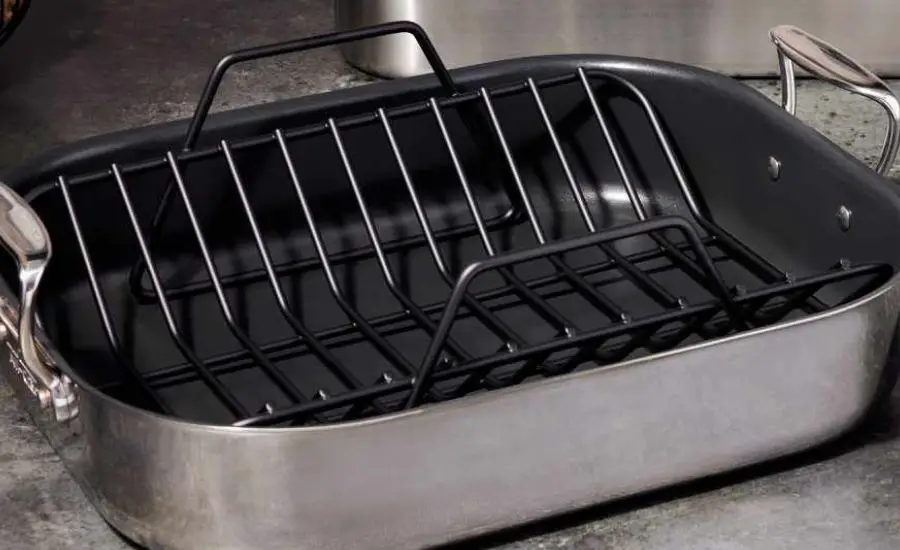
Cleaning and maintenance
Properly caring for your roasting pan is crucial to ensuring its longevity and continued performance. After the cooking process, it’s advisable to let the pan cool down slightly before cleaning to prevent warping in the case of some materials, such as stainless steel or aluminum.
For dishes like a casserole dish or a rimmed baking sheet, you can simplify cleanup by using aluminum foil to line the pan before cooking.
Foil roasting pan prevents food residues from adhering to the pan’s surface, making it much easier to clean.
After cooking, soaking the pan in soapy water for a short while can help loosen any stubborn food particles. A sturdy baking sheet can double as a scrubbing surface for stubborn residues.
If you encounter discoloration or stains, a paste made from baking soda and water can often do wonders in restoring the pan’s shine. This eco-friendly and budget-friendly cleaning method using baking soda is a kitchen hack worth keeping in mind for maintaining your cookware.

Other uses for oven pans
Oven pans are incredibly versatile tools in the kitchen, extending beyond their primary function. Use the roasting rack to elevate dishes in a casserole dish, promoting even cooking and enhancing flavors. A broiler pan, often included with ovens, can serve as a makeshift roasting pan for smaller items like vegetables or fish.
For culinary adventures beyond traditional roasting, consider using your roasting pan as a paella pan for a delicious Spanish rice dish, or as a vessel for roasting a whole chicken to golden perfection.
When fitted with a roasting rack, they provide the ideal vessel for roasting a succulent and flavorful whole chicken, ensuring that it cooks evenly and retains its juices.
It should be noted cooling rack is an indispensable tool in any baker’s kitchen. This elevated grid of metal or wire allows freshly baked goods, like cookies or cakes, to cool uniformly. By placing baked items on a cooling rack, you enable air to circulate them, preventing condensation and ensuring they maintain their ideal texture and consistency.
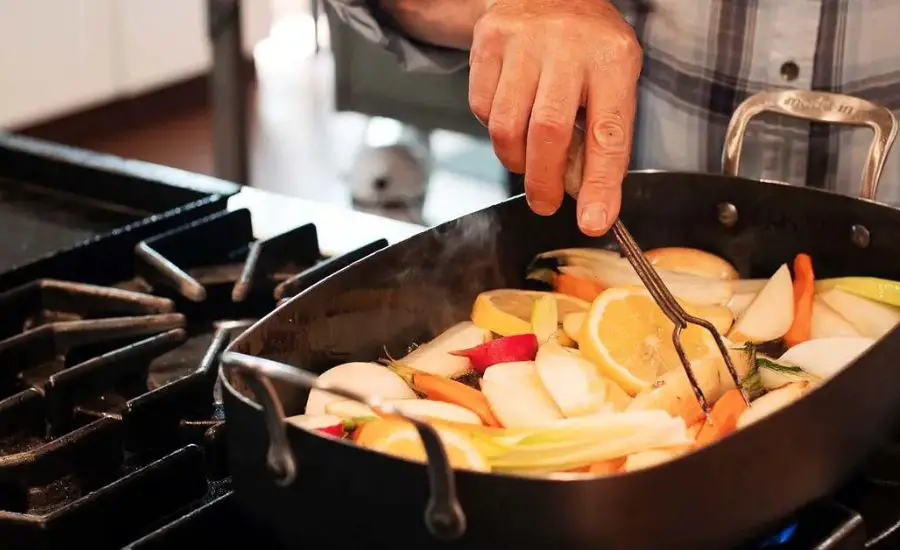
Roasting-pan alternatives
A casserole dish, for instance, can serve as an effective alternative for smaller cuts of meat or vegetables, although it may not provide the same heat distribution as a dedicated roasting pan.
In a pinch, aluminum foil can be shaped into a makeshift foil roasting pan to contain juices and assist with cleanup.
It’s worth noting that these pan substitutes may not offer the same durability or heat retention as a traditional roasting pan, but they can get the job done for many recipes.
Ultimately, while a roasting pan makes roasting and baking more efficient, innovative use of available kitchen tools can help you achieve similar results when a dedicated roasting pan is not at hand.
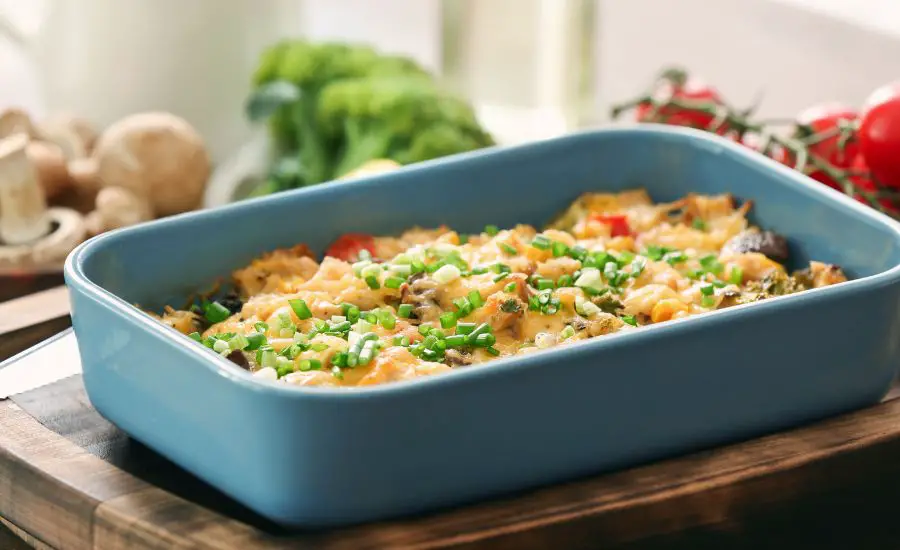
FAQ
Can I use a baking pan instead of a roasting pan?
Yes, you can use a baking pan as a roasting pan substitute in many cases. However, to achieve the best results when roasting meat or poultry, it’s recommended to include a roasting rack inside the baking pan to elevate the food and allow for even cooking and proper air circulation.
What is the difference between a roasting pan and a baking pan?
The primary difference between a roasting pan and a baking pan lies in its design and intended use. A roasting pans typically features higher sides, and a roasting rack, and is specifically designed for roasting large cuts of meat and poultry. In contrast, a baking pan has lower sides and is suitable for a wide range of baking and roasting tasks, including vegetables and smaller cuts of meat.
What can you use instead of a roaster pan?
If you don’t have a roasting pan, you can use roasting pan alternative, including a rimmed baking sheet with a roasting rack, a Dutch oven, or even a carbon steel skillet. These alternatives can help achieve similar results when roasting or baking your favorite dishes.
How high are the sides of a roasting pan?
The sides of a roasting pan are typically high enough to contain the juices released during the roasting process, usually measuring around 2 to 3 inches in height. This design helps prevent spills and facilitates the basting process.
Does a roasting pan go in the oven?
Yes, a roasting pan is specifically designed for use in the oven. It can withstand high temperatures and is an essential tool for roasting dishes to perfection in the oven.
Conclusion
The roasting pan shines as a versatile tool for perfecting your roasting and oven-cooking adventures. Whether you’re cooking meat, poultry, or an assortment of delectable vegetables, a well-chosen roasting pan can make all the difference.
However, when you find yourself in need of a roasting pan substitute, rest assured that you have various options at your disposal. From foil roasting pans and casserole dishes to rimmed baking sheets with a roasting rack, these roasting pan alternatives and roasting pan substitutes allow you to adapt and achieve excellent results in your cooking endeavors.
Moreover, oven pans and their various alternatives also double as convenient cooling racks for freshly baked goods, highlighting their versatility in the kitchen. Whether you’re a seasoned chef or a home cook experimenting with roasting food, understanding the options available to you will help you improve your culinary creations and ensure that every meal you serve is a masterpiece.

My name is Emma Brown, more than 15 years of my life is related to cooking, and i know all about selecting the right kitchen equipment for certain processes.
I will help you learn more about dishes and give you knowledge on how to extend the service life of cookware.

